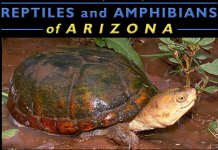| Range: |
 |
| Other Names: |
|
| Description: |
A small (shell up to 165 mm or 6.5" in length ) turtle with a dome shaped shell. The carapace is flat on top and is usually olive-brown to yellow-brown in color. The marginal shields (see figure below) are often yellow. The underside of the shell (plastron) is yellow and has two hinges so that the front and back can close when the turtle retreats inside. The top of the head is gray or brown and there are small, fleshy projections on the throat. The throat and sides of the face are plain yellow or cream distinguishing this turtle from the similar looking Sonora Mud Turtle which has reticulations on the head and neck. |
| Similar Species: |
The Sonoran Mud Turtle is most similar but differs in having a strongly mottled head, the ninth marginal not higher than the eigth, a slightly longer and higher domed carapace and a more extensive plastron. The Snapping Turtle has a very small cross-shaped, unhinged plastron. Painted, sliders (Pond and Big Bend) and Cooters have large unhinged plastrons. The Box Turtle has a plastron with a single front hinge. |
| Habitat: |
Found primarily in low valley bottoms, usually in or near sources of permanent or temporary water. It frequents pools within washes, ponds, cattle tanks, large puddles, and ditches. |
| Behavior: |
A semi-aquatic turtle that is most active during the day. During the warm season it spends most of its time in the water. Occasionally travels overland during rainy conditions. Hibernates in an underground burrow during the cold months of winter and aestivates underground during the hot, dry summer months. When captured or threatened it may emit a foul smelling musk from glands on the sides of the body. |
| Hibernation: |
|
| Reproduction: |
Mating takes place in summer and a clutch of up to 10 brittle-shelled eggs are laid in an underground nest in summer. Females may remain in the nest with the eggs for several days after laying them. |
| Diet: |
The Yellow Mud Turtle is primarily carnivorous. It feeds on insects, snails, fish, frogs, and carrion. It may also eat some plant material. |











